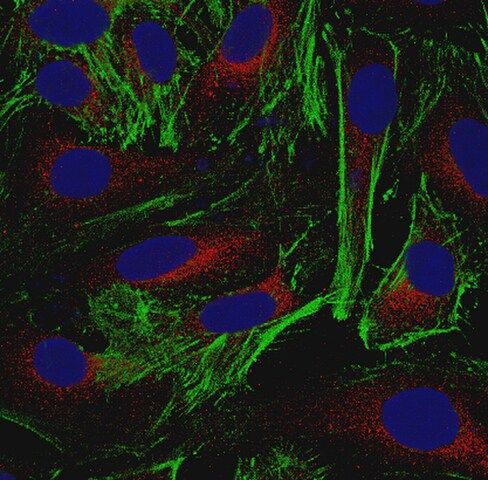您的位置:首页 > 产品中心 > Anti-Actin Antibody, clone 2G2
Anti-Actin Antibody, clone 2G2

产品别名
Anti-Actin Antibody, clone 2G2
Actin, alpha skeletal muscle, Actin, Alpha-actin-1, G-actin, Nuclear actin
基本信息
| eCl@ss | 32160702 |
| General description【一般描述】 | Actin, alpha skeletal muscle (UniProt P68135; also known as Alpha-actin-1) is encoded by the ACTA1 (also known as ACTA) gene (Gene ID 100009506) in Oryctolagus cuniculus (Rabbit) species. Actins exist in a variety of structural states, depending on the specific ionic conditions or the interaction with ligand proteins. The oligomeric and polymeric forms that actin molecules assume are dependent on the distinct conformations they adopt. Research indicates distinct actin conformations/structures in the nucleus and the cytoplasm of different cell types and that their distribution varies in response to external signals. In additon to serving as the basic building blocks of cytoskeletal microfilaments, actins are involved in multiple nuclear functions and adopt specific conformations that are important for their association with nuclear actin-binding proteins. |
| Specificity【特异性】 | Clone 2G2 recognizes a tripartite epitope identified in a region of the actin monomer (G-actin) that is not exposed on the surface of filamentous F-actin, but is accessible on the surface of profilin-complexed actin molecule (Gonsior, S.M., et al. (1999). J. Cell Sci. 112 (Pt 6):797-809). |
| Immunogen【免疫原】 | Epitope: Nonsequential epitope formed by regions within a.a. 104-226. Reconstituted complex of rabbit skeletal muscle actin and calf thymus profilin. |
| Application【应用】 | Research Category Cell Structure Anti-Actin Antibody, clone 2G2 is an antibody against Actin for use in Immunocytochemistry, Western Blotting. Immunocytochemistry Analysis: 5.0 µg/mL from a representative lot detected Actin in serum-starved C2C12 mouse myoblasts. Immunocytochemistry Analysis: A representative lot showed fixation-dependent cellular staining by fluorescent immunocytochemistry. Clone 2G2 stained nuclear dot-like structures, but not cytoplasmic myofibrils and stress-fibers (MF & SF) in formaldehyde-fixed chicken and mouse myogenic cells, while MF & SF, but not nuclei staining was seen in methanol-fixed chicken cardiac myocytes, fibroblasts, and in vitro differentiated chicken skeletal muscle myotubes (Gonsior, S.M., et al. (1999). J. Cell Sci. 112 (Pt 6):797-809). Immunocytochemistry Analysis: A representative lot detected nuclear actin immunoreactivity in formaldehyde-fixed COS and NIH-3T3 fibrobastic cells, normal rat kidney NRK epithelial cells, and Xenopus oocytes by fluorescent immunocytochemistry (Gonsior, S.M., et al. (1999). J. Cell Sci. 112 (Pt 6):797-809). Immunocytochemistry Analysis: A representative lot, when microjected into FH12 rat fibroblasts prior to formaldehyde fixation, showed dot-like staining of cytoplasmic actin monomer (G-actin), but not the microfilament (e.g. myofibrils and stress-fibers) structures (F-actin) seen with FITC-phalloidin staining (Gonsior, S.M., et al. (1999). J. Cell Sci. 112 (Pt 6):797-809). Immunocytochemistry Analysis: A representative lot detected subnuclear compartmentalized ss-actin immunoreactive foci in onion (Allium cepa) cells by immunofluorescent confocal microscopy (Cruz, J.R., et al. (2009). Chromosoma. 118(2):193-207). Immunocytochemistry Analysis: A representative lot detected actin immunoreactivity in the nucleus, in the submembraneous actin web, and at the filopodia tips by fluorescent immunocytochemistry staining of fixed rat fibroblasts and HeLa cells (Jockusch, B.M., et al. (2006). Trends Cell Biol. 16(8):391-396). Western Blotting Analysis: A representative lot showed a broad-spectrum species (rabbit, chicken, mouse) reactivity against SDS-denatured actins (alpha, beta and gamma) by Western blotting. However, clone 2G2 displayed no reactivity toward slime mold (Physarum polycephalum) actin or actins from muscle tissues of several invertebrate species (Gonsior, S.M., et al. (1999). J. Cell Sci. 112 (Pt 6):797-809). Western Blotting Analysis: A representative lot detected actin in all soluble and insoluble fractions of onion (Allium cepa) nuclei preparations (Cruz, J.R., et al. (2009). Chromosoma. 118(2):193-207). Western Blotting Analysis: A representative lot detected an internal actin fragment corresponding to a.a. 104-226 of rabbit skeletal muscle alpha-actin obtained by limited proteolytic digestion (Gonsior, S.M., et al. (1999). J. Cell Sci. 112 (Pt 6):797-809). Research Sub Category Cytoskeleton |
| Quality【质量】 | Evaluated by Immunocytochemistry in serum-starved HeLa cells. Immunocytochemistry Analysis: 5.0 µg/mL of this antibody detected Actin in serum-starved HeLa cells. |
| Physical form【外形】 | Purified by Ion-Exchange Chromatography Purified mouse monoclonal IgMκ antibody in PBS with 0.05% sodium azide. Format: Purified |
| Other Notes【其他说明】 | Concentration: Please refer to lot specific datasheet. |
产品性质
| Quality Level【质量水平】 | 100 |
| biological source【生物来源】 | mouse |
| antibody form【抗体形式】 | purified immunoglobulin |
| antibody product type | primary antibodies |
| clone【克隆】 | 2G2, monoclonal |
| species reactivity | human, mouse, rat, frog, rabbit, chicken, monkey |
| technique(s) | immunocytochemistry: suitable western blot: suitable |
| isotype【同位素/亚型】 | IgMκ |
| UniProt accession no.【UniProt登记号】 | P68135 |
| shipped in【运输】 | wet ice |
| Gene Information | human ... ACTA1(58) |
产品说明
| Target description【目标描述】 | ~42 kDa calculated |
| Storage and Stability【储存及稳定性】 | Stable for 1 year at 2-8°C from date of receipt. |
| Disclaimer【免责声明】 | Unless otherwise stated in our catalog or other company documentation accompanying the product(s), our products are intended for research use only and are not to be used for any other purpose, which includes but is not limited to, unauthorized commercial uses, in vitro diagnostic uses, ex vivo or in vivo therapeutic uses or any type of consumption or application to humans or animals. |
安全信息
| Storage Class Code【储存分类代码】 | 12 - Non Combustible Liquids |
| WGK | WGK 2 |





